Pyroxenes and Pyroxenoids
Steven Dutch, Professor Emeritus, Natural and Applied Sciences, Universityof Wisconsin - Green Bay
Pyroxenes and Pyroxenoids have single chains of silica tetrahedra. Two oxygen atoms in each tetrahedron are contained wholly within the tetrahedron and the remaining two are shared for a net formula of SiO3. However, since the tetrahedra in a pyroxene alternately point in opposite directions, there are two tetrahedra in each repeat unit, so most pyroxenes have formulas with Si2O6. Pyroxenoids are more complicated.
Pyroxenes
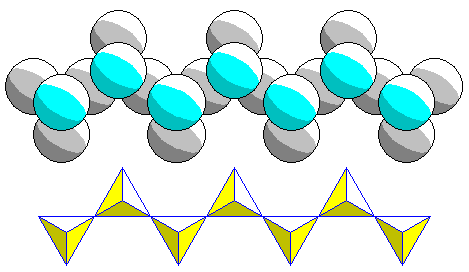
Most textbooks show the structure of a pyroxene chain as above, with tetrahedra pointing symmetrically outward.
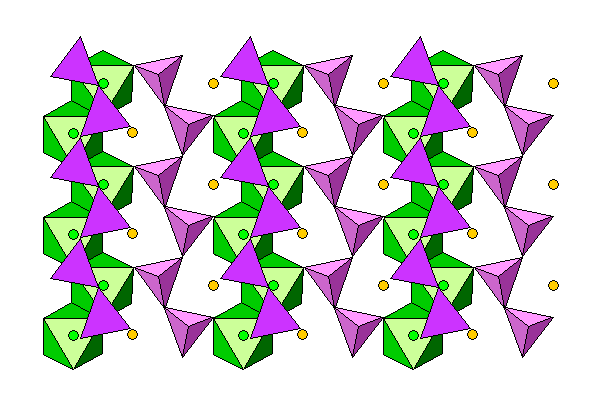
The reality is that the chains are more zig-zag as shown here. Silica tetrahedra are purple. The ionic charge on an Si2O6 unit is +8-12 = -4, so cations with a total charge of +4 have to be present to balance each unit. There are two cation sites. One, shown in green, is pinned between silica chains and tends to be a fairly regular octahedron. This site is generally labeled M1. None of the polyhedra are perfectly regular and the exact geometry is governed by cation charge and ionic radius. The other site, shown in orange, has a lot more room and is generally labeled M2. That space difference turns out to be immensely signifcant.
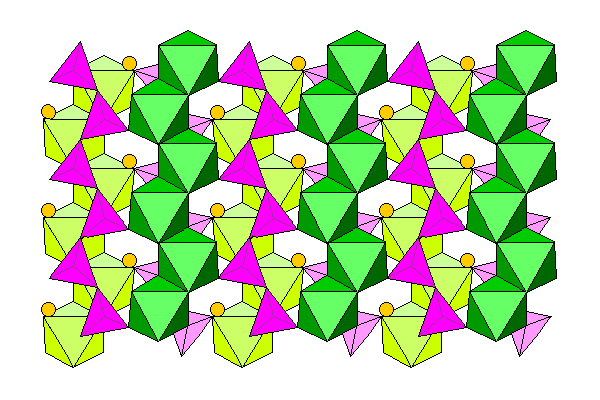
Above are two levels of tetrahedra and octahedra, with the background level in lighter colors.
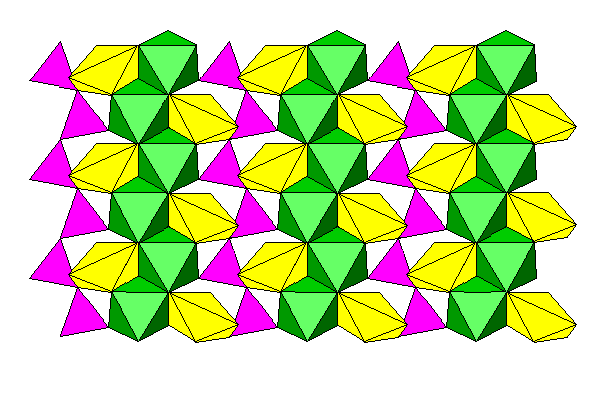
If the M2 cation is small, its coordination polyhedron is a distorted octahedron. Bear in mind that coordination polyhedra are purely conceptual; it's not like they're little glass boxes locking the ions in place. The reason the M2 cations don't fill all the available void space is their mutual repulsion keeps them as far apart as possible.
Why are the outer octahedra distorted? In closely confined structures, ions experience forces from all directions and tend to organize symmetrically. Here, though, the outer oxygen atoms are unconfined. But they still experience repulsion from the other atoms in the octahedron. Since there's open space for them to move, they do.
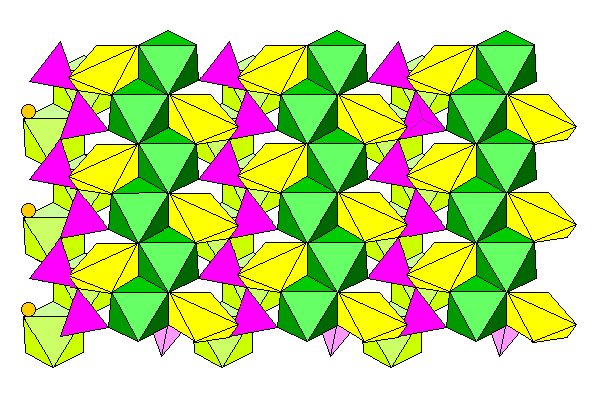
Above are two layers of the structure, with M2 octahedra shown only in the top layer. The "free" vertices of each M2 octahedron are shared with oxygens in a silica chain above the plane of the diagram.
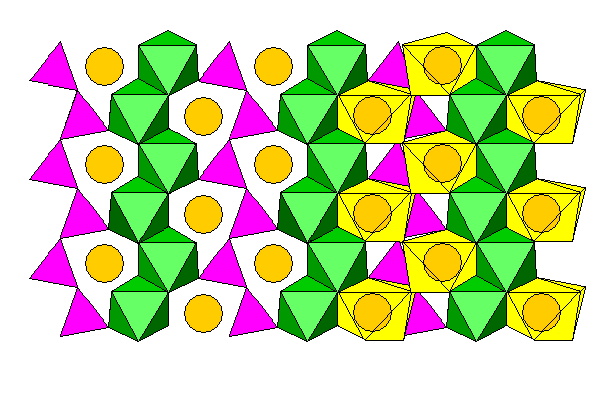
Now, here's where it gets interesting. If the M2 cation is large, it can take up the whole void space and its coordination polyhedron is more complex as shown above. Large cations, like calcium and sodium, can only occupy M2 sites. Thus, it's possible to have pure magnesium pyroxenes like enstatite (Mg2Si2O6). The pure iron pyroxene, ferrosilite (Fe2Si2O6), is a theoretical end-member rarely encountered. These are the only two single-cation pyroxenes simply because any other cation will probably have large amounts of Fe or Mg substitution. The vast majority of Fe-Mg pyroxenes are the intermediate mineral hypersthene.
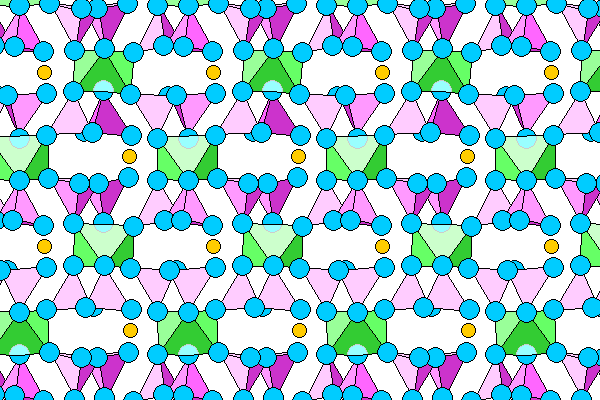
Above we see an end-on view of the pyroxene structure. The M1 octahedra are in green and the M2 cations in orange. Note the large amount of "rattle room" for the M2 cations.
Pyroxenoids
Since large cations can only occupy the M2 sites, no true pyroxene can have more than 50% large cations. Thus, diopside (CaMgSi2O6) is a true pyroxene, but wollastonite, (CaSiO3) is not. Jadeite (NaAlSi2O6) is a true pyroxene, but there is no pure sodium pyroxene. Wholly apart from the size problem, it's impossible on charge balance grounds. That's also why there are no pure aluminum pyroxenes.
Wollastonite
One of my most vivid field trip memories is encountering a dazzling white wollastonite marble in the desert in California. It had huge spears of wollastonite and was so tough sledgehammers simply bounced off it. (It's no longer collectible, alas, since it's inside the expanded boundaries of Death Valley National Park.)
Since calcium is a large cation, it won't fit into the M1 sites of a standard pyroxene. The only way to accomodate silica chains to it is to kink them differently. The chains consist of scalloped chains with a repeat interval of three.
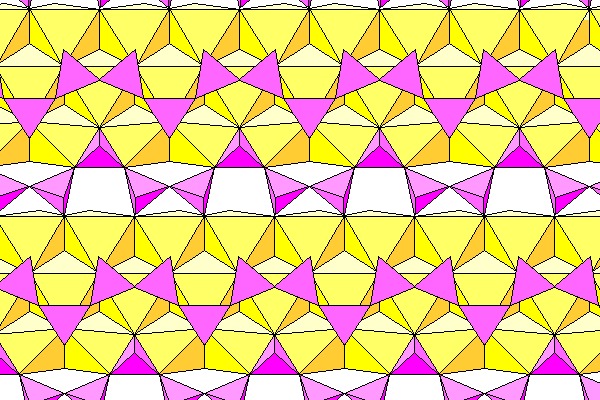
Above is a view of wollastonite perpendicular to the silica chains, and an end view is below. Yellow denotes Ca-O octahedra, and pink and purple signifies silica tetrahedra.
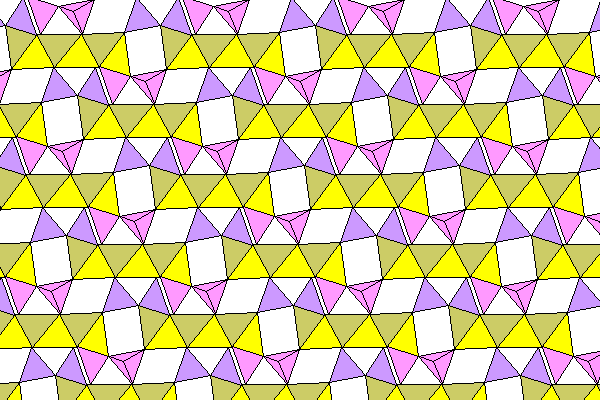
Rhodonite

Rhodonite is MnSiO3, and manganese is a fairly normal small transition metal cation, so it's a little hard to see why its structure isn't that of a normal pyroxene. It almost always has some calcium, which may create enough distorted sites to explain the structure. The cation sites are strips made up of en echelon chains of octahedra with distorted polyhedra on each end.

In order to fit this structure, the silica chains are wavy, with a repeat interval of five. One set of chains links the cation strips and points up. The other chain runs down the middle of the strip and points down. These chains also link to the next layer.

Pyroxmangite
Pyroxmangite is the high pressure, low temperature polymorph of rhodonite and has a closely related structure. Again, the cation strips consist of en echelon chains of octahedra, with irregular polyhedra at each end. But the strips cross link to create an open grid.

In pyroxmangite, the silica chains have a repeat interval of seven.
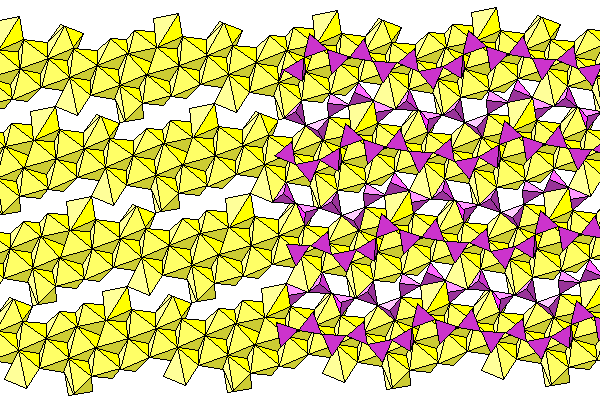
So why are Pyroxenoids so ... Kinky?
 | Ultimately, blame it on calcium. The problem is easiest to see with wollastonite. 1. A conventional pyroxene chain with cation octahedra. The medium-sized cation forms an octahedron small enough for pairs of tetrahedra to span. 2. If the cation is calcium, the octahedra are too big for silica tetrahedra to link. 3. A side view. 4. the only way to link tetrahedra across the Ca-O octahedron is to cant them toward each other. 5. Canting the tetrahedra inward allows pairs to link up, but then there is no way to link the pairs. 6. We can form chains by alternating mirror image pairs of tetrahedra, but note that the chains now cut obliquely across the chains of Ca-O octahedra, as shown below. The structure is made up of en echelon segments of Ca-O chains, or three parallel chains of octahedra joined along opposite edges. |

Manganese is a nice, well behaved mid-sized cation, so why doesn't it form nice pyroxenes? Well, it's a lot less common than iron and magnesium, so it's most likely to substitute into hypersthene or augite. Situations where distinct manganese silicates form are uncommon. There is a magnesium-manganese pyroxene, kanoite. But rhodonite and pyroxmangite usually have enough calcium to distort the octahedra, but not enough to form a manganese equivalent of diopside.
Return to Mineralogy-Petrology Index
Return to Thin-Section Index
Return to Crystals and Light Index
Return to Crystal Structures Index
Return to Mineral Identification Tables
Return to Professor Dutch's Home Page
Created 22 February, 2001, Last Update 18 April, 2011